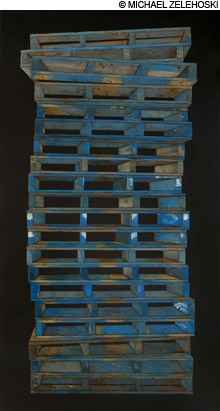
BLUE PALLETS Michael Zelehoski’s sturdy-seeming objects appear to warp and float and teeter in space. |
The longer you look at Michael Zelehoski's trompe-l'oeil images of shipping palettes, a striped construction barrier, and a ladder, the more something seems off, though it's difficult to say just what. And that's where the Lee artist's work gets awesome — and what makes it stand out in the very specifically titled exhibit "New and Recent Work by 13 Massachusetts Cultural Council 2010 Award Recipients in Painting and Drawing" at Tufts University Art Gallery.
Zelehoski's images are actually fashioned of painted wood strips that sit in slight relief against empty black or white backgrounds, which gives them a strange extra sensation of depth. He stretches perspective, often for a slight fish-eye feel. But look closely at his image of a construction-barricade crossbar. Note that the board's perspective lines flip as they run from side to side, creating an object that looks convincingly real, but is, in fact, a magical M.C. Escher impossibility. These sturdy-seeming objects appear to warp, float, and teeter in space, and you can't help but feel that the floor is falling out from under you.
Dorchester painter Cristi Rinklin's exhibit at Zevitas Gallery in October was some of the best art seen in the region last year. She explored the meeting point of painted and digital representations, and the junction of realism and abstraction. But what's made this recent body of work so striking is that she's channeling the 19th-century Hudson River School's take on landscapes. She continues that exploration at Tufts in paintings atop transparent Duralar laid over a marbled sheet — though the results are more uneven because of her taste for clashing, muddy, and acid colors. But she's at her best in What Was, which uses harmonies of grayed blues and greens to depict mountains reflected as if in a lake, plus billowing, cartoony smoke clouds and swirling lines. Like the Hudson River School gang, it inspires feelings of rapture.
>> SLIDESHOW: The MCC Awards at Tufts, 'Flourish' at MassArt, and 'The Cave Project' <<
Yanick Lapuh of Brookline fashions folksy, cartoony, painted-wood figures — a brown demon holding daisies, a bat-head creature standing atop a ladder in a hole. They are curious, symbolic paintings that give the impression of an artist possessed. Harold Reddicliffe of Waltham paints hyperrealist still lifes of small engines, often against handsome matching-color backgrounds that are the ultimate in cool, detached, uptight precision — if you're into that sort of thing.
It's good that the MCC funds artists and organizes exhibits. And it's pathetic that Massachusetts has cut MCC funding by $4.25 million or 34 percent over the past few years while also giving our financial industry tax breaks for 15 years. (Apparently, noble capitalists can't get by without our handouts.) But on the whole, I wish many of these 13 grant winners were more exciting. The art often feels conservative or academic. Even when the craft is impressive, the artists often seem to have little they care about and little to say.
One of the basic characteristics of the Boston art scene is that a significant portion of it is a transient community of students and teachers affiliated with our schools. My definition of local art is art actually made here — generally by people living here. That said, we could do more to tap into the energy of our transient folks — to help keep more of them here, or at least to engage with them while they're here. And why not claim them even when they move on? The Museum of Fine Arts may not soon begin paying more attention to art made here, but as it programs its Linde Family Wing for Contemporary Art, which opens in September, it's definitely thinking of alumni who've left town. The first big show in the new wing will feature School of the Museum of Fine Arts alum Ellsworth Kelly, and the MFA recently acquired a celebrated video by Massachusetts College of Art and Design alum Christian Marclay.
Speaking of alumni, I visited MassArt's "Flourish," a roundup of works on paper by 64 of its alumni — most of them still residing hereabouts. This isn't a celebrity show, so absent are alumni like William Wegman, Ed Emberley, Sam Durant, Tony Millionaire, and the collective Paper Rad. (Did you realize that MassArt has been such a spawning ground for arty cartooning and humor?) The art here shows two major trends coming out of the school — conceptually driven photography (likely inspired by a faculty noted for this, including Nicholas Nixon, Abelardo Morell, Laura McPhee) and handcraft.
Claire Beckett of Jamaica Plain (who has been photographing the costumed rehearsals of American soldiers practicing for war in the Mideast) and Jess Dugan of Cambridge (whose past work includes portraits of queer couples) exemplify MassArt alums' bent for specimen-collecting in lush detail with medium- or large-format cameras. This photography often has an emotional distance akin to the deadpan expressions of fashion photography, but also reflecting the use of cumbersome cameras that require photographers to compose images upside down.